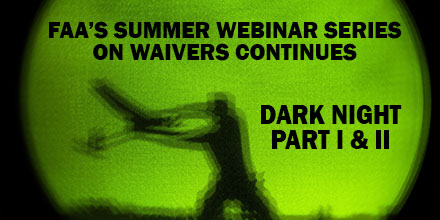
The Federal Aviation Administration (FAA) continues its
Summer Webinar Series with Dark Night Part I and Part II.
These webinars are no-cost. Any drone operator who is interested in obtaining a daylight operations waiver (107.29) to conduct night-time operations is welcome to attend.
Due to heavy demand, the FAA lifted capacity restrictions. Now, both registered and non-registered individuals are invited to login.
Dark Night: Part I
Dark Night: Part I is on Tuesday, July 24 at 1 pm EST. Discussion centers around the unique challenges involved with operating at night.
Additionally, the webinar aims to help operators understand how best to describe the proposed operation -- as is required in the
Waiver Safety Explanation Guidelines (WSEG).
The one-hour webinar includes time for attendees to ask FAA experts about the application process.
Dark Night Part II
Dark Night: Part II is on Thursday, July 26 at 1 pm. The topics covered include questions 2-5 of the WSEG.
The webinar runs for 30-minutes.
Accessing the Webinar
The FAA's Summer Webinar Series is hosted entirely online through
Adobe Connect. The FAA encourages attendees to login at least 15-minutes prior to the webinar.
Those interested in attending can connect via two methods:
- Download the Adobe Connect smartphone app and click here. Select the "Enter as a Guest" option; provide a Name and click, "Enter Room".
- Officially register for the Summer Webinar Series, by clicking here.
Keep in mind, playback media requires flash. Check to ensure your device has the latest version of Adobe Flash Player. To submit questions to the FAA experts, ensure your microphone works. Participants can always refer to the Adobe Connect How-To guide
(PDF).
The Summer Series Webinars are free of charge.
Future Webinars Include:
The FAA began the Summer Webinar Series to help drone operators submit better waiver requests. Each webinar is live and allows attendees to ask FAA experts waiver questions. Upcoming webinars, include:
August 7 @ 1 pm EST
The Good, The Bad, The Ugly - Using real examples, this session reviews the differences between a success and unsuccessful waiver application.
August 21 @ 1 pm EST:
Beyond Visual Line of Sight - Why is this so difficult to obtain? This episode focuses on the "holy grail" of waivers.
September 4 @ 1 pm EST:
Operating Limitations: Altitude - Learn how to fly above the 400' altitude ceiling with an operation limitation (altitude) waiver.
September 18 @ 1 pm EST
Operations Over People - Why are there so few approvals for this waiver? Session addresses the mitigation necessary to ensure an operation doesn't endanger people on the ground
Past Webinars
Drone operators who missed previous sessions of the series are in luck. Operators can view each webinar via the FAA's official YouTube channel. Past webinars, include:
Where is my Waiver - Find out what is involved in the waiver application process. Learn how to apply for what you really want.
Risky Business - Successful waivers include detailed risk assessments. Learn how to identify hazards, assess the risk they pose to your operation and develop methods to reduce the identified risk.
Just the Facts - The importance of good data to support your proposed operation and safety case is key to successfully applying for a waiver. Learn why Requests for Information positively support your application and what to do in your safety mitigation.
 The Federal Aviation Administration (FAA) continues its Summer Webinar Series with Dark Night Part I and Part II.
These webinars are no-cost. Any drone operator who is interested in obtaining a daylight operations waiver (107.29) to conduct night-time operations is welcome to attend.
Due to heavy demand, the FAA lifted capacity restrictions. Now, both registered and non-registered individuals are invited to login.
The Federal Aviation Administration (FAA) continues its Summer Webinar Series with Dark Night Part I and Part II.
These webinars are no-cost. Any drone operator who is interested in obtaining a daylight operations waiver (107.29) to conduct night-time operations is welcome to attend.
Due to heavy demand, the FAA lifted capacity restrictions. Now, both registered and non-registered individuals are invited to login.

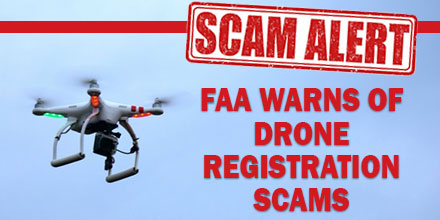 The
The  Hemisphere GNSS recently announced the launch of its all-new multi-GNSS, multi-frequency 4-helix HA32 UAV antenna.
The HA32 is a high-performance antenna. It supports GPS, GLONASS, Galileo, BeiDou, and Hemisphere's Atlas L-band correction service.
Designed specifically for UAVs, GIS, surveying, and RTK. It is also highly suitable for applications requiring high-precision positioning and navigation.
Hemisphere GNSS recently announced the launch of its all-new multi-GNSS, multi-frequency 4-helix HA32 UAV antenna.
The HA32 is a high-performance antenna. It supports GPS, GLONASS, Galileo, BeiDou, and Hemisphere's Atlas L-band correction service.
Designed specifically for UAVs, GIS, surveying, and RTK. It is also highly suitable for applications requiring high-precision positioning and navigation.
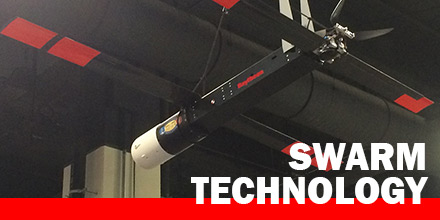 Raytheon‘s BBN Technologies announced it is developing technology to direct and control swarms of small, autonomous air and ground vehicles.
This technology falls under DARPA’s Offensive Swarm-Enabled Tactics program.
The technology includes:
Raytheon‘s BBN Technologies announced it is developing technology to direct and control swarms of small, autonomous air and ground vehicles.
This technology falls under DARPA’s Offensive Swarm-Enabled Tactics program.
The technology includes:
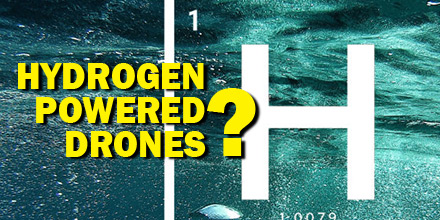 Battery life.
This continues to be one of the biggest challenges for drone operators.
Currently, the average flight time of most consumer drones is limited to around 20 minutes. Of course, this number varies depending on many things - weather conditions, payload, etc.
Ultimately, though, battery life continues to be a challenge for long flight operations. Eventually, a drone must return and recharge or switch out batteries before operations can continue.
Battery manufacturers, of course, continuously work to improve battery technology. But, there may be a completely new solution on the horizon...hydrogen fuel cells.
Recently, researchers in Sydney, Australia, successfully conducted UAV test flights using hydrogen-powered fuel cells. The results were promising.
Battery life.
This continues to be one of the biggest challenges for drone operators.
Currently, the average flight time of most consumer drones is limited to around 20 minutes. Of course, this number varies depending on many things - weather conditions, payload, etc.
Ultimately, though, battery life continues to be a challenge for long flight operations. Eventually, a drone must return and recharge or switch out batteries before operations can continue.
Battery manufacturers, of course, continuously work to improve battery technology. But, there may be a completely new solution on the horizon...hydrogen fuel cells.
Recently, researchers in Sydney, Australia, successfully conducted UAV test flights using hydrogen-powered fuel cells. The results were promising.
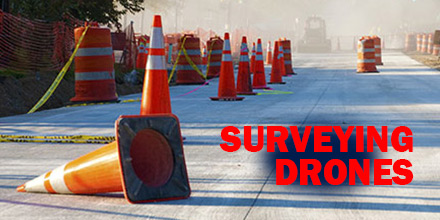 In recent years, it’s fair to say that drones have come a long way in terms of mainstream acceptance.
From the initial skepticism of both the ordinary public and commercial entities, drones moved beyond niche hobbyists to one of the most in-demand technologies.
Now, the technology is disrupting the road construction industry, as well.
In recent years, it’s fair to say that drones have come a long way in terms of mainstream acceptance.
From the initial skepticism of both the ordinary public and commercial entities, drones moved beyond niche hobbyists to one of the most in-demand technologies.
Now, the technology is disrupting the road construction industry, as well.
